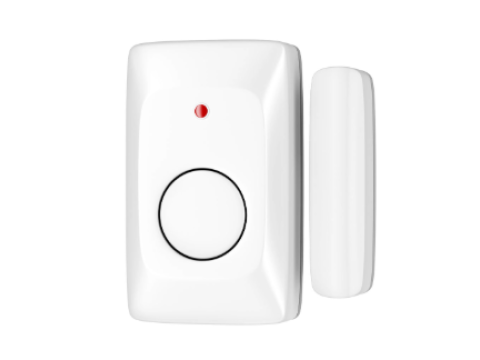Magnetic contact sensors (often called “reed switches” or “magnetic switches”) are point detectors that monitor the opening of doors, windows, hatches, gates, and more. They’re essential in security alarm systems for detecting non-destructive entry attempts. Below, we’ll explore their basic principles, types, and installation recommendations.
How Magnetic Contact Sensors Work
A typical sensor consists of two parts:
Reed Switch (Sensitive/Execution Unit)
- A sealed, magnetically operated contact (normally closed for security use).
- Wires connect to the alarm panel or transmitter.
Magnet (Actuating Unit)
- Positioned so that, when the window or door is closed, it aligns closely with the reed switch.
- Moving (opening) the door or window separates the magnet from the reed switch, causing the contacts to open and trigger an alarm signal.
Wired vs. Wireless
- Wired sensors connect directly to the alarm circuit (or “zone”) in the control panel.
- Wireless sensors integrate a small radio transmitter and battery alongside the reed switch. While convenient, they’re typically larger (housing electronics) and more expensive.
Key Technical Specifications
Contact Ratings (Voltage & Current)
- Generally low because standard alarm loops carry minimal current.
- Avoid passing high current through a reed switch to prevent contact damage or welding.
Operating Distances
- “Close” distance: The gap at which the reed switch closes (when the magnet approaches).
- “Open” distance: The gap at which the switch opens (when the magnet moves away).
- Usually range between 0.4–1 inch for residential sensors, though this can vary.
Material Considerations
- Metal Doors: Require stronger magnets or specific “metal door” sensor kits (the metal can weaken the magnet’s field).
- Wood or Plastic Doors: Standard sensors suffice.
Types of Magnetic Contact Sensors
Surface-Mount vs. Recessed
- Surface-Mount: Screwed or glued onto visible areas. Easier to install; minimal drilling.
- Recessed: Hidden within door/window frames. A neater look but requires more drilling.
Miniature vs. Heavy-Duty
- Miniature: Aesthetically discreet, commonly used on vinyl or wooden windows.
- Heavy-Duty: Larger, with a stronger magnet for robust doors, gates, or rolling shutters.
Indoor vs. Outdoor
- Outdoor-Rated sensors come with weatherproof casings, used for gates or external fences.
- Indoor sensors typically have plastic housings.
Addressable
- Rare but available: Each sensor has a unique digital address for advanced security systems. Usually more expensive.
- Alternatively, standard sensors can connect to an addressable “expander module,” grouping multiple contact sensors into one zone.
Installation Guidelines
Mounting
- Reed switch on the stationary frame.
- Magnet on the moving door/window.
- Keep them within manufacturer-specified distances for reliable open/close detection (often < 1 inch).
Position
- Max distance from door/window edge: ~8 inches. This prevents partial opening (for sabotage).
- Concealed wiring: If possible, run cables behind walls or through frames. Exposed wires may risk tampering.
Securing Against Tampering
- For high-security areas, recessed sensors hide the switch and magnet from view.
- Some installers place two sensors in series, spaced apart, to thwart attempts at bridging or using a “fake magnet.”
Wireless Concerns
- Radio interference or thick metal doors might reduce wireless range.
- Plan for easy battery replacement and strong enough signals if you mount on a far corner.
Common Applications
Doors & Windows
- Standard for perimeter security—monitors opening even before motion detectors spot intrusion.
- Particularly useful for “armed stay” modes in residential systems, allowing motion inside while perimeter remains guarded.
Garage Doors & Gates
- Larger heavy-duty sensors handle bigger gaps and more robust magnets.
- Outdoor-rated devices for weather resistance.
Hatches, Cabinets, Safes
- Miniature or specialized sensors for smaller enclosures or tilt-based detection.
Object Tamper Detection
- Some use magnets/switches to detect if a valuable object (like a painting or safe) is moved.
Potential Drawbacks & Mitigations
Sabotage by Additional Magnet:
- An intruder might try to “override” the sensor by placing another magnet in its place.
- Recessed sensors or multiple sensors in series help combat this tactic.
Electrical Overload:
- Reed switches are fragile if used for anything but a low-voltage alarm circuit.
- Avoid using them to switch power for other devices (motors, large relays).
False Alarms
- Usually minimal for contact sensors (they’re mechanical), unless installed incorrectly or cables get pinched.
Conclusion
Magnetic contact sensors form the first line of defense in many security systems—“point detectors” that reliably sense opening/closing of doors, windows, or hatches. While they’re straightforward to install and use, remember:
- Select the correct type (surface vs. recessed, standard vs. heavy-duty).
- Position for minimal gap and tamper resistance.
- Wire or configure (wireless) according to brand-specific guidelines and local codes.
When implemented correctly—possibly combined with motion detectors or glass-break sensors—they provide an effective perimeter layer against intrusions. For help choosing the right magnetic contact sensor and integrating it into your alarm system, visit safsale.com. Our security experts can guide you through selecting, wiring, and testing solutions to ensure a robust defense for your property.

